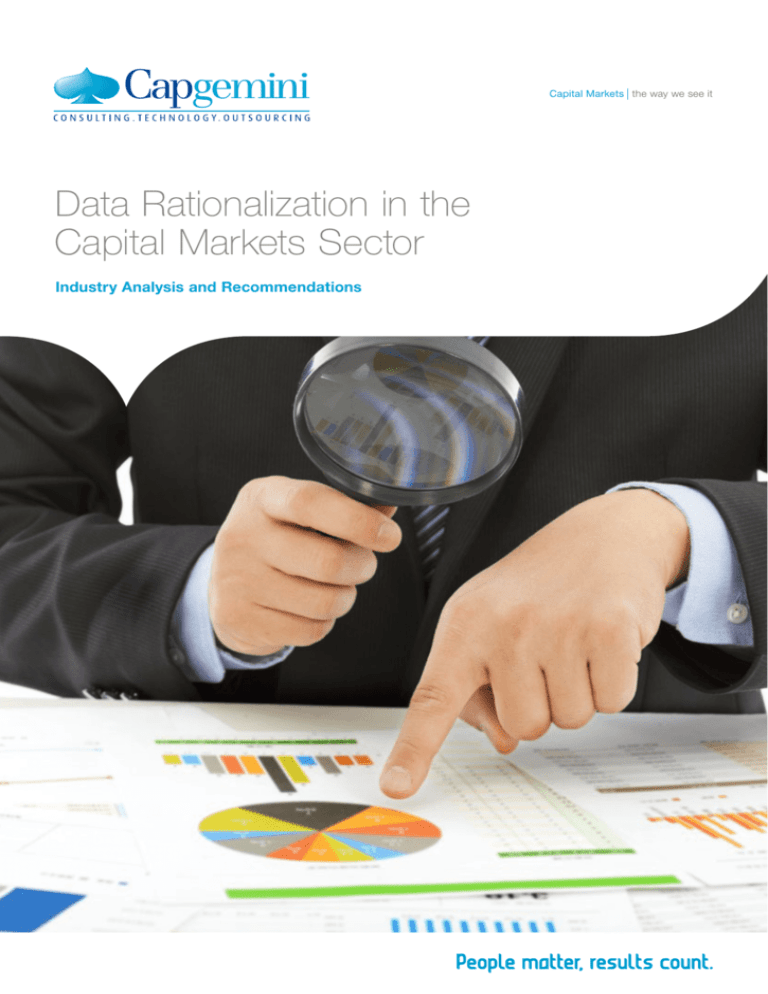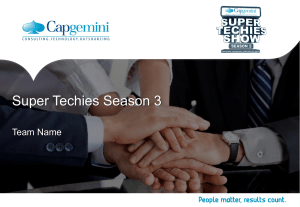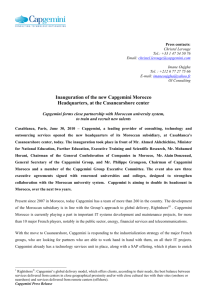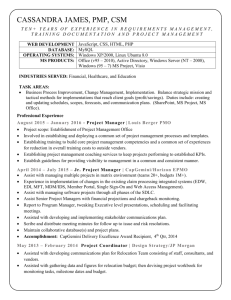
Capital Markets the way we see it
Data Rationalization in the
Capital Markets Sector
Industry Analysis and Recommendations
Table of Contents
1. Introduction
3
2. About Capgemini’s Capital Markets Data Management Survey 2013
4
3. Key Findings
5
4. IT Spending Continues to Rise
6
5. What’s Causing Complexity in Data Management?
7
6. Companies Are Slow to Adopt Standards for Data Management
10
7. Companies Count on Consolidation to Save Costs, but Few are
Taking Immediate Action
12
8. Rationalization Strategies That Work: Understand the
Current Challenges and Move Forward with Greater Clarity
15
9. Data Infrastructure Rationalization Journey
18
The information contained in this document is proprietary. ©2014 Capgemini. All rights reserved.
Rightshore® is a trademark belonging to Capgemini.
the way we see it
1.Introduction
The capital markets industry has long been awash in data, which has truly become
the lifeblood of the industry. However, deriving business value from burgeoning data
volumes amid increased budgetary and regulatory pressures is becoming more
challenging. Capital market firms are looking for ways to streamline and consolidate
data to convert ever-growing amounts of data into useful business information.
Organizations are also looking to rationalize the amount they spend on external
data providers.
Over the years, IT teams have been building data infrastructure to support specific
business functions. Mergers and acquisitions brought even more data sources
into the companies’ IT landscapes, leading to uncontrolled proliferation of data
and driving up the cost of information management. At the same time the business
needs have changed. Business users now demand a data infrastructure that delivers
relevant information cost-effectively, on-demand, in a format that’s easy to process,
and from a more manageable number of sources. Recent regulations have forced
the capital markets firms to re-evaluate their data management infrastructure –not
only to provide required regulatory reports, but to proactively manage their data
to deliver benefits such as near real-time risk aggregation, compliance record
retention and disposition, centralized reference data management across products,
counterparties etc.
We have many hundreds of databases but
really only a small proportion that are driving
the business now. Previous mergers have left
us with a large number of legacy databases
that we have it support as they are still used—
however infrequently.”
CIO, U.S. Capital Markets firm
In an effort to control costs, reduce redundancy and make better business sense of
their mounting amounts of data, companies are beginning to put in place standardsbased data governance frameworks. However, most data infrastructure initiatives are
still in early stages, often plagued by lack of consistent approach, long-term vision
and business buy-in. Many modernization projects don’t get adequate funding due
to the fact that it’s difficult to demonstrate immediate return on investment (ROI), and
companies continue to spend resources just “keeping the lights on” maintaining their
existing assets.
3
2. About Capgemini’s Data Management
Survey for Capital Markets
As an advisor to capital markets firms, Capgemini has seen that the cost of data
management can be much larger than is popularly recognized in the industry. To
take a closer look at how our clients are approaching the urgent need to modernize
and restructure redundant data sources, Capgemini conducted a series of phone
interviews with over 50 senior IT and business executives from large global capital
markets companies in the U.S. and U.K. in Q4 2013. Our research focused on the
general aspects of IT infrastructure budgets and policies and specifically zeroed in on
data management practices, challenges, risks and rationalization strategies.
Capgemini’s Data Management Survey for Capital Markets is aimed to help answer
questions from our capital markets clients about how their data management
infrastructure cost compares to industry peers and examine potential solutions for
rationalizing data infrastructure to gain operational efficiency, manage risk, increase
regulatory compliance and reduce the operational costs.
Research Highlights
• Capgemini’s Capital Markets Data Management Survey for 2013 includes
responses from 50 senior executives from large global capital markets firms in the
U.S. and U.K., with multiple respondents per company.
• Respondents’ titles and job functions include: Chief Information Officer, Chief
Operations Officer, Chief Technology Officer, Head of Compliance, Head of Risk
and Business Units Head.
• All interviews were conducted using a telephone research approach to gather
feedback on a variety of topics related to data management and provide a unique
perspective from senior IT and business leaders.
Exhibit 1: Distribution of survey respondents
Other
10%
COO
14%
Business
Unit Head
24%
Head
of Risk
Head of
10% Compliance
14%
CTO
14%
CIO
14%
Source: Capgemini’s Data Management Survey for Capital Markets 2013
Our research confirms that a large opportunity exists for capital markets firms
to reduce costs and significantly improve their data quality and consistency by
rationalizing their databases and consolidating data sources using a methodical,
building-block approach based on industry standards and governance practices. It is
also evident that many IT and business leaders still underestimate the true extent of
their data redundancy problem, and don’t have an immediate plan to address it.
4
Data Rationalization in the Capital Markets Sector
the way we see it
3. Key Findings
The research revealed the following key points:
• Spend on IT: As a percentage of revenue, the annual IT budget is around 3.1%,
ranging from 1.5% for smaller financial institutions to around 6% for large firms.
• Total Spend on Data: On average 17.5% of the global IT budget is allocated to
data infrastructure, ranging from 15% to 25% annually.
• Spend on Data Management: The budget for data infrastructure and
administration comprises over half (52%) of the total annual data spend.
• Spend on Data Providers: The amount allocated to data provider vendors is
around 48% of total annual data budget.
• Data Governance Challenges: Only around 50-60% of applications comply
with the data governance and tools standards prescribed by organizations.
• Complexity: There’s evidence of multiple instances of many databases across
the organizations, adding cost and complexity to the IT operation.
• Cost Reduction: IT leaders express clear desire to drive out costs in data
infrastructure. An overwhelming majority of respondents (82%) state that they are
looking to consolidate, streamline and drive down data infrastructure operations
cost by 20-25% annually.
5
4. IT Spending Continues to Rise
IT spending continues to represent a significant percentage of companies’
budgets. For multi-billion dollar corporations, this translates into hundreds of
millions of dollars being allocated annually to support IT projects. Not surprisingly,
data infrastructure represents a significant portion of the global IT budgets. The
Capgemini research participants indicate that on average 17.5% of their IT spending
is allocated to data infrastructure, with an even split across data vendors (48%) and
data management (52%).
Our level of spend is very high but even then
I do not think it is enough. We need to invest
more on innovation technologies as opposed
to keeping the lights on, but with so much
legacy it is a real challenge.”
CIO, U.S. Capital Markets firm
In a company with an overall IT budget in excess of $800 million (based on the $812
million average reported by participating IT and business leaders), this suggests a
data infrastructure spend in excess of $142 million. The research didn’t differentiate
between cloud-based or physical data infrastructure components – it aimed primarily
at assessing the overall level of annual investment that companies dedicate to their
data management.
Exhibit 2: A Sample Business Case for a Financial Firm
with $100 Billion Annual Revenue
Spend on IT
Total spend on data
Spend on data management
Spend on data providers
Potential cost savings
Additional benefits from
optimizing data management
3.1% of revenue
$ 3.1 billion per year
17.5% of the global IT budget
$ 550 million per year
52% of total data spend
$ 290 million per year
48% of total data spend
$ 260 million per year
15-20% of total data spend
$ 80-110 million per year
• Improved data governance
• Increased transparency
• Timely availability of data
• Improved compliance with regulation
• Single view of across multiple data dimensions
6
Data Rationalization in the Capital Markets Sector
the way we see it
5. What’s Causing Complexity in
Data Management?
The largest complexity in data management in Capital Markets firms stems from
the lack of transparency into the data landscapes. Let us consider a typical Capital
Markets firm with 10,000 active databases. On average, lets us assume that each
of these databases have a 100 tables with 20 columns each. This means that the
organization needs to manage 20 million columns of data. Semantic reduction of
this data, using data profiling techniques, into a manageable number of business
concepts critical to the business is a foundational stepping stone towards dealing
with the specific complexities listed below.
Exhibit 3: The five major causes of complexity in data
management
Governance
Tools
Multiple database
technologies, ETL, MDM,
distribution and reporting tools
makes integration difficult
and increases Total Cost of
Ownership
Integration
Proliferation of multiple data
sources, multiple standards
and tools makes it very difficult
to integrate and maintain data
for business purposes
A lack of strong governance
and standards has resulted
in redundant and overlycomplex data architectures
and duplicative data
management processes
Complexity
in Data
Management
Increased Cost
Data Redundancy
Data management in silos has
led to proliferation of similar
data across LOBs, operational
databases and data marts
resulting in tremendous data
redundancy
Technology Adoption
Businesses are unable to adopt
promising new technologies
like cloud computing and Big
Data rapidly due to internal
data integration challenges
Integration
The volume of digital information in today’s business environment is truly
unprecedented, and it’s growing faster every day. Companies are able to use data to
track business transactions, identify trends, analyze and manage risk and aggregate
a vast variety of information in real time for reporting and compliance purposes.
However, all too often the tools that are used to capture, store and process this data
are inconsistent, storing data in different formats, utilizing different taxonomies and
structures. Data integration problems cause unforeseen business issues such as the
inability to view a single transaction across systems, or inaccurate aggregation and
reporting of essential data leading to excessive risk exposure.
7
The role of data aggregation in the global financial crisis
A recent example of weak data aggregation capabilities can be seen from
the analysis of the global financial crisis that began in 2007. Many of the
financial services firms’ IT groups found themselves unable to compile
and analyze risk exposure information across business lines and between
different legal entities, resulting in serious financial consequences for the
banks and the financial system as a whole. As part of the recovery effort,
the financial services industry is working on implementing a number
of initiatives aimed at strengthening the data aggregation capabilities,
including a Legal Entity Identifier (LEI) – a system designed to identify all
parties participating in financial transactions across the globe. This type
of system can only be built when companies’ data sources are integrated
and governed in a sustainable way across and between organizations.
Tools
Without a set of consistent management methods and processes throughout
the enterprise, various business units, groups and IT teams tend to use disparate
technologies and tools to gather and handle data assets. Naturally, lack of standard
processes and tools exacerbates data integration problems, resulting in low
data quality and compliance challenges. It also creates inefficiencies in having to
maintain and support multiple database management and warehousing solutions,
such as Extract, Transform and Load (ETL) or Master Data Management (MDM)
tools. The data management rationalization process includes transforming the way
organizations approach the toolset and talent used to manage information and
setting up processes that can be utilized company-wide, to gain control, save costs
and strengthen their data management capabilities.
8
Data Rationalization in the Capital Markets Sector
the way we see it
Data Governance
Data governance is often referred to as a discipline for analyzing, managing,
controlling and protecting the company’s information. Clearly, no governance can
take place without an in-depth understanding of what information exists within
multiple sources in the organization, what data elements are critical to the business
success and which entity is accountable for the quality of the data. The key to
a successful governance model is a common, standard, enterprise-wide model
for managing people, processes, tools and technologies involved in handling the
corporate data.
Data Redundancy
Inconsistent data management practices across systems often lead to data quality
and consistency issues.
Redundant heterogeneous IT systems, with a multitude of devices and sources often
capturing esoteric information, all with a lack of standards or consistent aggregation
or reporting all create redundancy problems. There’s no “quick win” approach
to eliminating redundancy. The solution for streamlining the information sources
within the organization is to establishing and following solid governance practices
throughout the enterprise.
Technology Adoption
Cloud computing, mobile, big data are the latest technology trends that are quickly
gaining popularity for their potential to save costs, improve customer satisfaction and
better respond to emerging business trends and opportunities. However, they are
adding even more complexity to the already complicated and cluttered IT landscape.
IT leaders are finding it increasingly difficult to integrate new, forward-looking
technologies into their enterprise infrastructure. Before major initiatives such can be
tackled, organizations need to rationalize their existing IT environments, focusing
specifically on data architecture and processes.
9
6. Companies Are Slow to Adopt
Standards for Data Management
An overwhelming majority of surveyed financial firm executives (86%) suggest that
their organizations have a set of approved standards for data management and
integration tools. Standardization is a proven way to reduce operational cost and
minimize risk, however the respondents also reveal that two out of five of existing
applications (41%) don’t adhere to those standards. Over a third (35%) of research
participants say that less than half of their IT systems meet the prescribed data
management standards.
Exhibit 4: What percentage of applications adhere to
prescribed standards for data management and
integration tools?
30%
14%
12%
12%
9%
7%
7%
5%
2%
1%-10%
2%
11%-20% 21%-30% 31%-40% 41%-50% 51%-60% 61%-70% 71%-80% 81%-90% 91%-100%
Source: Capgemini’s Data Management Survey for Capital Markets 2013
This data suggests that despite the growing understanding of the importance
of consistent data management, many companies are still very early in the
process of standardizing and optimizing their IT infrastructure and may not have
the right expertise and methodology to implement an enterprise-wide data
governance practice.
10
Data Rationalization in the Capital Markets Sector
the way we see it
We have recently implemented a standard for
data management and integration tools which
has really helped the business get greater
control of data and systems. But to be honest
not all of the applications adhere to the
standard yet—that will take a lot more time.
And time is money in this business.”
CIO, U.S. Capital Markets firm
Underestimating the Problem
One surprising observation that surfaced while reviewing the study came from the
discussion on the overall number of databases and database instances. The majority
of surveyed IT and business leaders state that their companies have between three
and four instances of various types of databases (enterprise, pricing, security,
transaction etc), while their IT teams are supporting an average of 20 databases
across the entire organization. Such low number is in stark contrast with industry
data and Capgemini’s experience with large enterprise clients, which suggest that
global financial services organizations would typically maintain thousands – or even
tens of thousands of production and non-production databases. We feel that this
gap is illustrative of how data and its related IT budget tends to grow much faster and
more insidiously than most organizations realize.
Most legacy applications were traditionally built to use their own databases,
and for each production application, IT usually maintains additional instances
for development, training and testing/QA. As a result, a number of databases
can quickly reach into thousands, with each instance requiring administration,
maintenance, upgrades and support.
Perhaps the fact that IT leaders are not aware of the extent of the database
redundancy and complexity problem suggests that they don’t see data management
as a priority until a major crisis forces them to address it.
11
7. Companies Count on Consolidation
to Save Costs, but Few are Taking
Immediate Action
Despite the differences in interpreting the number of database instances, research
data confirms that there’s a clear need among financial services firms to drive out
costs in data infrastructure. Nearly all respondents (92%) state that they are looking
to consolidate and streamline their data infrastructure landscape in order to reduce
costs and gain efficiency. Industry data suggests that well-planned and carefully
executed consolidation projects can deliver savings between 20 and 30%.1 The
Capgemini research participants concur that their organizations are targeting an
average of 21.5% in cost reduction.
Exhibit 5: How strongly do you agree with the following
statement? We are looking to consolidate, streamline and
drive operations cost down in our data infrastructure
Disagree
2%
Neither agree
nor disagree
4%
Disagree
strongly
2%
Strongly agree
38%
Agree
54%
1 Gartner Inc., “IT Key Metrics Data 2014: Key Industry Measures: Banking and Financial Services
Analysis: Current Year” Jamie K. Guevara, Linda Hall, Eric Stegman, , 16 December 2013
12
Data Rationalization in the Capital Markets Sector
the way we see it
Exhibit 6: What percentage cost savings are you targeting
given Gartner says 20-30% cost savings are possible?
31%-40%
7%
41%-50%
4%
1%-10%
26%
21%-30%
28%
11%-20%
35%
We initially were targeting around 15% cost
savings but we think that we can achieve
more than that now and are looking at 21%.
Maybe Gartner is right.”
CTO, U.K. Capital Markets Firm
However, like all changes, data infrastructure modernization does not happen
overnight. Projects that involve identifying and consolidating multiple data sources
require careful planning, methodology and phased approach. Less than a third of
all respondents (28%) say that their organizations have a fully developed roadmap
for rationalizing their application data, while an additional 62% state that they are in
the process of identifying the necessary tasks and timelines, and expect to have a
modernization roadmap completed within 6 to 12 months.
13
14
Data Rationalization in the Capital Markets Sector
the way we see it
8. Rationalization Strategies That Work:
Understand the Current Challenges
and Move Forward with Greater Clarity
Capgemini’s Capital Markets Data Management Survey clearly shows that the
need for data rationalization is real and urgent. However, regaining control over
information proliferation is not an easy task and cannot be solved overnight.
Companies that carefully address their data problem can gain significant savings;
achieve better risk management, reduced costs and better data quality.
As we are looking to generate greater
efficiencies within the operation; consolidate,
streamline and drive operations cost down in
our data infrastructure. We also want to put
more focus on innovation.”
CTO, U.K. Major Capital Markets Firm
Capgemini offers a variety of services designed to understand the organizations’
current challenges, assess existing data infrastructure, analyze existing redundancy
issues, create consolidation plans and build a phased approach to establishing
consistent data management practices.
Exhibit 7: Levers to Reduce Cost and Improve Efficiency
Levers
1
Database Rationalization
& App Decoupling
Business Benefits
• Reduce licensing, maintenance and
operational costs
• Reduce data vendor costs
2
Vendor Data and tools
consolidtaion
3
Master Data Management
4
Data Governance
5
Automation
6
New technology adoption
7
Leverage and reuse
• Reduce development and integration
costs
• Introduce standardization
• Establish Single Version of Truth, reduce
integration costs
• Unified standards across the
organization, improve Data transparency,
availability
• Reduce manual overheads in data
reconciliation and improve accuracy
• Reduce hardware and storage footprint
and improve ROI
15
Scan: Discover and Profile Enterprise Data Sources
The transformation process begins with discovering all existing enterprise data
sources and understanding the extent of database redundancy and duplication.
Applying industry tools can accelerate and automate data source analysis; however
the most important element of the discovery phase is a structured approach that can
help understand and catalog data subject areas, connect data sets with supported
business processes and identify data owners, producers, consumers, usage
patterns and volume.
From there, it is possible to analyze data stores based on supported functionality,
subject areas and product types to identify potential overlaps and group data stores
in clusters based on similarity of content, functionality, consumers etc. Once data
clusters have been identified, they can be prioritized for further analysis based on
factors like potential duplication, total cost of ownership, return on investment, or
platform alignment.
Exhibit 8: Capgemini’s Transformation Process
A
Scan —
Information Gathering
B
Focus —
Redundancy Analysis
Act —
C Consolidation
Cross
references
Consolidation
Strategy Selection
✔
Data
Discovery
Systems Catalog
Data Gathering
✔
Vertical and
Horizontal Data
Analysis
✔
Impact Analysis
Attribute
Mapping
✔
Indentify
Candidates for
Redundancy
Data Cluster
Identification
Data Usage
Work Package
Prioritization
Column
Analytics
Systems
Catalog
Source: Capgemini Analysis 2014
16
Data Rationalization in the Capital Markets Sector
Data Gap
Remediation and
Migration
Consumer
Migration
✔
Usage
Analysis
DB Retirement
Validate
Candidates
the way we see it
Focus: Apply a Common Model and Identify Data
with Redundant Sources
After the information gathering phase is completed, the next step is to perform
thorough redundancy analysis. Capgemini experts can help you conduct automatic
data discovery and profiling to identify cross-referencing points and map similar
columns across databases. For each column, it is essential to understand what type
of information is being stored, what subject areas it refers to and what business
processes and activities it supports, as well as how frequently this data is being
used. As part of vertical and horizontal data analysis, Capgemini experts can help
conduct focused coverage analysis to find any existing overlap of information across
multiple data sources and measure the amount of overlap. These findings, along
with data usage analysis and input from stakeholders and other sources such as the
Systems Catalog serves as basis for identifying redundant databases.
Act: Consolidate Redundant Sources and Migrate Data
to Target Platform
The implementation phase begins with identifying consolidation strategies for various
duplication and overlap scenarios. The decision to eliminate or consolidate various
data sources needs to take into account potential impact of eliminating redundant
data on consumers and identify key changes required for the environment, business,
operations and support processes. Any data gaps that occur during consolidation
need to be remedied. Capgemini experts can help you define the migration approach
and steps, including identifying all consumers who need to be migrated to the target
database and outlining required transformation in consuming system to leverage
target system data. After the systems have been consolidated and data migration
finalized, the Capgemini experts can help you identify which systems are candidates
for retirement, validate reduced data usage, purge data, retire the database as
well as corresponding hardware and software and remove retired assets from
system inventory.
17
9. Data Infrastructure Rationalization
Journey
Application Portfolio Rationalization initiatives are undoubtedly among the top items
on any CIOs agenda. Faced with budget pressures, IT organizations are looking for
ways to streamline their application landscape, reduce the number of obsolete and
redundant systems and consolidate data sources to improve accuracy, consistency
and transparency. With our many years of experience in guiding Financial Services
clients through all aspects of IT landscape modernization projects Capgemini can
help you create and implement a comprehensive plan for your data infrastructure
rationalization initiative using our proven, structured approaches with standard
methodologies and tools.
Exhibit 9: Capgemini Solution Enablers
Systems Catalog
• Standardized and proven application checklists and questionnaires
to enable rapid information gathering on data stores
• Automated data discovery tools to enable centralization of
documented and un-documented metadata
Data Discovery
• Preconfigured data discovery /profiling modules to identify data
redundancy
• Cross-referencing business rules libraries to perform vertical/
horizontal coverage analysis
Semantic Models
• Semantic models for Client, Product and Transaction data which
are used to establish Common Information Models and drive crossreferencing and redundancy analysis
Consolidation
• Industry-leading Wide Angle Application Rationalization (WARP)
methodology to drive application rationalization and data
consolidation
• Application retirement and data archiving services
Data Migration
• Proven Data Migration Methodology and Proprietary Data Migration
Workbench for automated data migration
• Automated generation of data migration and reconciliation routines
reduce risk and improve time to market
18
Data Rationalization in the Capital Markets Sector
the way we see it
About the Authors
Aloke Paskar leads the Capital Markets team for North America and
the U.K. within Capgemini’s Financial Services Global Business Unit. In
this role, Aloke is responsible for overseeing business operations, client
relationships, sales, and delivery for Capital Markets in the two regions.
Previously, Aloke served in two leadership roles within the financial
services team at Capgemini, first as Head of the Asia Pacific business unit
and more recently as Vice President of India and China Operations.
With over 22 years of global experience in the financial services industry,
Aloke has worked extensively in implementing global delivery and
business operations across multiple locations including the U.S., India,
Philippines and China. He graduated from Calcutta University with a major
in Economics and has an MBA from the XLRI School of Business and
Human Resources in Jamshedpur, India.
Arindam Choudhury leads the data management solutions competency
focused on Capital Markets for the Business Information Management
practice within Capgemini’s Financial Services Global Business Unit. In
this role, Arindam is responsible developing, marketing and implementing
industry solutions for our Capital Markets customers.
With over 17 years of global experience in the financial services industry,
Arindam has worked extensively in the data management space
developing innovative solutions for his clients that helped reduce the total
cost of ownership and improve efficiency. Arindam has helped develop
industry-leading utility solutions for data management for financial services
organizations. He graduated from National Institute of Technology,
Surathkal, India with a major in Electronics and Communication.
19
Capital Markets the way we see it
About Capgemini
With 130,000 people in 44 countries, Capgemini is one of the
world’s foremost providers of consulting, technology and
outsourcing services. The Group reported 2013 global revenues of
EUR 10.1 billion.
Together with its clients, Capgemini creates and delivers business and
technology solutions that fit their needs and drive the results they want.
A deeply multicultural organization, Capgemini has developed its own
way of working, the Collaborative Business Experience™, and draws on
Rightshore®, its worldwide delivery model.
Learn more about us at
www.capgemini.com
For more information, contact us at: capitalmarkets@capgemini.com
or visit: www.capgemini.com/capitalmarkets
The information contained in this document is proprietary. ©2014 Capgemini. All rights reserved.
Rightshore® is a trademark belonging to Capgemini.












